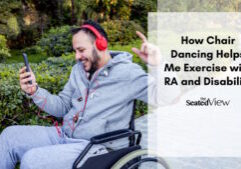Effortless: What Walking Looks Like to Someone Who Can’t Walk

I was 14 the last time I walked on my own steam and I did so with crutches and what felt like knives slicing through my joints at every step. Years of untreated juvenile arthritis had ravaged my body.
Thirty years later, walking no longer makes sense to me – I have no muscle memory of the things that have to happen in your legs when you take one step after another. It’s quite possible that if I magically became able to walk again by next Wednesday that it’d come back to me like riding a bike, but I honestly doubt it.
I remember reading about someone who had been blind for a long time and had an operation to get their sight back. I remember reading how terrible the consequences of the successful operation were – they had no idea what they were seeing, had no idea how to put the visual cues together to make sense to the point that they became profoundly disabled and could no longer be independent as they’d been while blind. Their brain had changed and they had to spend a long time relearning what seeing meant.
It hasn’t been very long that walking has been this alien to me – as recently as a few years ago, I still walked in my dreams. I don’t any longer – I’m either using my wheelchair or mysteriously hover, flashing between points instead of traveling between them, being in the living room, for instance, and in the next moment the kitchen (if only I could do that in real life, imagine how much I could get done!). I watch people walk, really watch the process and wonder that they can and so far, take so many steps. Effortlessly.
When I get to the Market fairly early on the day it opens after the weekend, I have watched my butcher slice bacon. He puts the hunk of meat into the slicer and stands there, palm up just below the rotating knife catching each slice as it falls, then turning his hand upside down and letting the slice fall again onto the tray. He does this over and over again, easily a hundred times or more, several times a week. Effortlessly.
I know that walking isn’t effortless. I know that slicing the bacon and arranging it in trays isn’t effortless. Effort goes into everything physical, regardless of how small or big the movement is. But when choosing the term effortless to describe such movement, I speak from within my world and in here, these movements and so many more look effortless. As effortless as a swan gliding through water, it’s feet paddling furiously below the surface, out of sight.
Not even in my wildest dreams could I do these things and what’s more, I can’t remember how. When I look at my butcher, so smoothly catching, turning and turning back to catch again I cannot comprehend that his elbow isn’t screaming after the first slice.
When I look at you walk, taking the garbage to the chute, popping to the grocery store, or running for the light, I cannot comprehend the ability to do so, to take that many steps, to carry on a conversation while doing it, to not keel over in a crumpled heap, screaming with the pain (not a ploy for sympathy, just a statement of what would happen should I make the attempt).
And when I look at athletes or dancers moving their body with such perfect synchronicity and precision, their bodies doing exactly what they have trained it to do, I cannot comprehend the ability to do so. Not just to do so painlessly – or relatively painlessly from my point of view – but the ability to do it at all.
Because it turns out that five decades of arthritis, four of using a power wheelchair and most of those years conditioning me, almost like a bonsai plant, to smaller movements, to no strength, to can’t, has impacted more than my body.
It has changed my brain, changed the link between my mind and body so significantly that making a body walk, slice bacon and all the tiny movements involved in swimming, gymnastics, soccer is a concept so alien as to be unimaginable.
And that’s why it looks effortless to me.
2 Comments
Read More
Discover what else I've been writing about...
















Very well explained! I feel the same about many movements, I seem to do so few that involve my legs with ease and without thought. I believe that this is a vital part of the spoon theory that most people miss. Its not just about the amount of spoons we have, its the number of spoons, or effort, required for each activity!
Exactly. That’s the thing about disability and illness — is not just about the inability to do things, is about the effort required. It’s one of the reasons for attendant care, for instance. Attendants are there to do what you can’t do yourself, or that which requires too much time or effort for you to do.